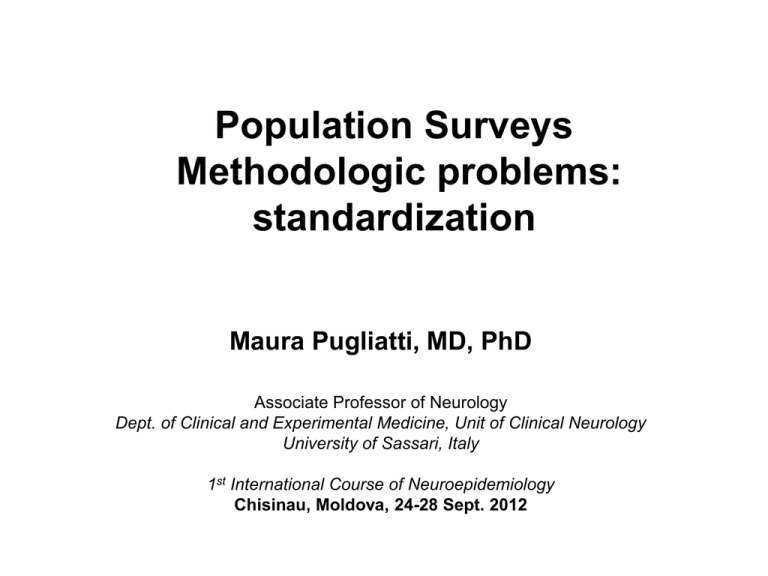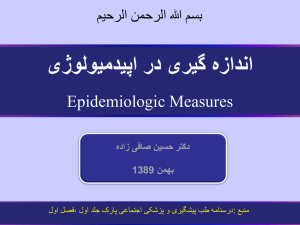
Population Surveys
Methodologic problems:
standardization
Maura Pugliatti, MD, PhD
Associate Professor of Neurology
Dept. of Clinical and Experimental Medicine, Unit of Clinical Neurology
University of Sassari, Italy
1st International Course of Neuroepidemiology
Chisinau, Moldova, 24-28 Sept. 2012
Disease determinants:
factors of importance for disease occurrence
Personal characteristics
Age
Year of Birth
Sex
Marital status
Occupation
Education
Income
Ethnic group/Religion
Time
Short term variations
Long term variations (secular changes)
Place
International variations
Regional variations
Local variations
Urban/Rural variations
Gallitto et al. Epilepsia, 2005.
Standardization
Standardization allows for comparisons when the population
structures differ and is key in assessing the potential influence of
environmental or cultural factors on disease rates in a region.
A standardized estimate is a crude estimate that has been adjusted
for differences in age composition between the study population and
a standard (referral) population.
Standardized estimate based on the same standard population are
comparable and the ratio between two standardized estimates is
called Standardized Rate Ratio (SRR)
Standardization for gender and age
There are two ways of computing standardized estimates:
- Direct Standardization: it calculates a weighted
average of the region’s age-specific estimates where
the weights represent the age-specific sizes of the
standard population.
- Indirect Standardization: it uses age-specific
estimates (eg., mortality) from the standard population
to derive expected estimates (eg., deaths) in the
region’s population.
Choosing which formula to use will depend on what data
you have access to.
Type of data we can have access to:
Table 1, US Population in thousands and State Age-Specific Mortality Rates
Age
0-4
5-24
25-34
35-44
45-54
55-64
65-74
75+
Population
US
18456
72053
43675
35264
24163
21830
17897
12470
Mortality New Mortality
York
Arizona
0,00272
0,00269
0,00066
0,00076
0,00192
0,00146
0,00321
0,00224
0,0054
0,00484
0,01212
0,01102
0,02793
0,02408
0,08753
0,07359
Direct Standardization
(eg., incidence, prevalence,
mortality)
Table 2, U,S, Age-Specific Mortality and State Populations in Thousands
Age
0-4
5-24
25-34
35-44
45-54
55-64
65-74
75+
US Death
Rate
0,00251
0,00065
0,00135
0,0022
0,00486
0,01236
0,0273
0,08513
New York
Population
1275
5023
3018
2572
1909
1784
1347
981
Arizona
Population
299
1028
614
479
315
307
277
170
Indirect Standardization
(eg., mortality)
Direct Standardization:
To compute the direct standardized mortality rate (SMR):
1. For each age group, you need to multiply Mr by Ps.
2. Add them up.
3. Divide the sum by the total standard population.
4. Multiply by 1000, or give the rate in terms of "per thousand population"
SDR1 = [Sum age groups (Mr x Ps)]/Pt x 1000
Mr is the age-specific mortality rate for the region.
Ps is the number of people in the age group in the standard population.
Pt is the total standard population.
Indirect Standardization:
To compute the indirect standardized mortality rate:
1. For each age group, you need to multiply Ms by Pr.
2. Add them up.
3. Divide the sum into the number of deaths in the region.
4. Multiply by the crude death rate.
SDR2 = Dr/[Sum age groups (Ms Pr)] x CDRs
Ms is the age-specific mortality rate for the standard population.
Pr is the number of people in the age group in the region’s population.
Dr is the number of deaths in the region.
CDRs is the crude death rate for the standard population.
DIRECT METHOD OF STANDARDIZATION
Examples
Example:
Table 1, US Population in thousands and State Age-Specific Mortality Rates
Age
Population
Mortality New Mortality
York
0,00272
0,00066
0,00192
0,00321
0,0054
0,01212
0,02793
Arizona
0,00269
0,00076
0,00146
0,00224
0,00484
0,01102
0,02408
NY
AZ
0-4
5-24
25-34
35-44
45-54
55-64
65-74
US
18456
72053
43675
35264
24163
21830
17897
50,20
47,55
83,86
113,20
130,48
264,58
499,86
49,65
54,76
63,77
78,99
116,95
240,57
430,96
75+
12470
0,08753
0,07359
1091,50
917,67
Tot
245808
2281,23
1953,31
SDR1 for New York = ???
SDR1 for Arizona = ???
SDR1 = [Sum age groups (Mr x Ps)]/Pt x 1000
Mr is the age-specific mortality rate for the region.
Ps is the number of people in the age group in the standard population.
Pt is the total standard population
SDR1 for New York =
9,3
SDR1 for Arizona =
7,9
Prevalence of ALS in northern Sardinia (prov. of
Sassari and Nuoro) in 2004
<35
35-44
45-54
55-64
65-74
75-84
85+
Tot
M
97725
37116
31494
26850
19544
10467
2788
225984
M
1
0
4
8
4
3
0
20
SS 2004
F
1
1
2
5
3
0
0
12
M
1,0
0,0
12,7
29,8
20,5
28,7
0,0
8,9
SS 2004
F
93407
37579
31413
28367
23266
15599
5069
234700
SS 2004
F
1,1
2,7
6,4
17,6
12,9
0,0
0,0
5,1
T
191132
74695
62907
55217
42810
26066
7857
460684
M
56678
20607
17787
14750
11653
6700
1846
130021
M
0
2
5
5
4
1
0
17
NU 2004
F
0
0
0
1
7
3
0
11
T
2
1
6
13
7
3
0
32
T
1,0
1,3
9,5
23,5
16,4
11,5
0,0
6,9
M
0,0
9,7
28,1
33,9
34,3
14,9
0,0
13,1
NU 2004
F
53519
19978
17189
15798
14247
9962
3279
133972
T
0
2
5
6
11
4
0
28
NU 2004
F
0,0
0,0
0,0
6,3
49,1
30,1
0,0
8,2
TOT 2004
F
146926
57557
48602
44165
37513
25561
8348
368672
T
110197
40585
34976
30548
25900
16662
5125
263993
M
154403
57723
49281
41600
31197
17167
4634
356005
M
1
2
9
13
8
4
0
37
TOT 2004
F
1
1
2
6
10
3
0
23
T
0,0
4,9
14,3
19,6
42,5
24,0
0,0
10,6
T
2
3
11
19
18
7
0
60
M
0,6
3,5
18,3
31,3
25,6
23,3
0,0
10,4
T
301329
115280
97883
85765
68710
42728
12982
724677
The island of
Sardinia, Italy
2004 census pop. (denominator)
Sardinian provinces of Sassari
and Nuoro
2004 number of ALS cases
TOT 2004
F
0,7
1,7
4,1
13,6
26,7
11,7
0,0
6,2
T
0,7
2,6
11,2
22,2
26,2
16,4
0,0
8,3
2004 ALS prevalence
Pugliatti M, Parish LD, et al. J Neurol, in press
Prevalence of ALS in northern Sardinia (prov. of Sassari and Nuoro) in 2004
<35
35-44
45-54
55-64
65-74
75-84
85+
Tot
M
0,4
0,0
1,7
3,6
2,0
1,6
0,0
9,3
8,9
M
11714767
4612114
3761710
3383481
2737383
1526720
332433
28068608
SS 2004
F
0,4
0,4
0,8
2,1
1,4
0,0
0,0
5,2
5,1
F
11247020
4579893
3851041
3609738
3282765
2433082
816098
29819637
T
0,4
0,2
1,3
2,8
1,7
0,8
0,0
7,2
6,9
M
0,0
1,6
3,8
4,1
3,3
0,8
0,0
13,6
13,1
T
22961787
9192007
7612751
6993219
6020148
3959802
1148531
57888245
NU 2004
F
0,0
0,0
0,0
0,8
5,4
2,5
0,0
8,6
8,2
WeightM
0,4173619
0,1643157
0,1340184
0,1205432
0,0975247
0,0543924
0,0118436
1
T
0,0
0,8
1,9
2,4
4,4
1,6
0,0
11,1
10,6
WeightF
0,3771682
0,1535865
0,1291445
0,1210524
0,1100874
0,0815933
0,0273678
1
M
0,3
0,6
2,4
3,8
2,7
1,6
0,0
11,2
10, 4
WeightT
0,396657
0,158789 Standard population
0,131508 2004 census pop. (denominator)
0,120806 ITALY
0,103996
0,068404
0,01984
1
TOT 2004
F
0,3
0,3
0,5
1,6
2,9
1,0
0,0
6,6
T
0,3
0,4
1,5
2,7
2,7
1,1
0,0
8,7
6,2
8,3
Standardized ALS
prevalence in northern
Sardinia
Crude prevalence
Pugliatti M, Parish LD, et al. J Neurol, in press
Prevalence and Characteristics of Epilepsy in the Aeolian Islands
Gallitto et al. Epilepsia, 2005.
Prevalence and Characteristics of Epilepsy in the Aeolian Islands
M
F
5-14
42357
39261
15-24
40421
38737
25-34
36087
36298
35-44
31843
31191
45-54
26647
27514
55-64
22230
23907
65-74
14707
17861
75+
10692
15151
Tot
224984
229920
5–14
15–24
25–34
35–44
45–54
55–64
65–74
>74
Total
M
5,01
0
2,9
4,27
2,99
1,41
6,76
0
2,95
F
5,09
2,56
3,03
4,58
4,63
0
4,27
1,99
3,3
WeightM WeightF WeightT
81618
0,188267 0,170759 0,179418
79158
0,179662 0,16848 0,17401
72385
0,160398 0,157872 0,159121
63034
0,141535 0,13566 0,138565
54161
0,11844 0,119668 0,11906
46137
0,098807 0,10398 0,101421
32568
0,065369 0,077684 0,071593
25843
0,047523 0,065897 0,05681
454904
1
1
1
T
T
5,05
1,25
2,96
4,42
3,75
0,73
5,41
1,24
3,13
Age-specific prevalence of
epilepsy in Aeolian Islands, 1999
Gallitto et al, Epilepsia 2005
5–14
15–24
25–34
35–44
45–54
55–64
65–74
>74
Total
M
0,94
0,00
0,47
0,60
0,35
0,14
0,44
0,00
2,95
F
0,87
0,43
0,48
0,62
0,55
0,00
0,33
0,13
3,29
1999 census pop. (denominator)
Northern Sardinian population
T
0,91
0,22
0,47
0,61
0,45
0,07
0,39
0,07
3,19
Standardized prevalence of epilepsy
to the 1999 Sardinian pop.
Gallitto et al. Epilepsia, 2005.
Prevalence and Characteristics of Epilepsy in the Aeolian Islands
Crude prevalence
Stand. Prev to 2001 Italian pop.
Stand. Prev to 1999 Sardinian pop.
M
F
T
2,95
2,87
2,95
3,30
3,15
3,29
3,13
3,01
3,19
per 1000
Gallitto et al. Epilepsia, 2005.
*
*
Gallitto et al. Epilepsia, 2005.
DIRECT METHOD OF STANDARDIZATION
Other Examples
Direct standardization
Example:
Pop.
0-29 yrs
30-59 yrs
60+ yrs
Total
3145000
3057000
1294000
7496000
Sweden
Deaths Mortality
3523
10928
59104
73555
1,1
3,6
45,7
9,8
Pop.
741000
275000
59000
1075000
Panama
Deaths Mortality
3904
1421
2456
7871
5,3
5,2
41,6
7,3
The choice of a standard population affects the comparison.
Here the Sweden population is used as standard, the Panama rates applied to
this population
0-29 yrs
30-59 yrs
60+ yrs
Total
3145000*5,3/1000
3057000*5,2/1000
1294000*41.6/1000
SMR:
SRR
86231,5*1000/7496000
11.5/9.8
16569,6
15796,4
53865,5
86231,5
11,5
1,17
Direct standardization
Example:
Pop.
0-29 yrs
30-59 yrs
60+ yrs
Total
3145000
3057000
1294000
7496000
Sweden
Deaths Mortality
3523
10928
59104
73555
1,1
3,6
45,7
9,8
Pop.
741000
275000
59000
1075000
Panama
Deaths Mortality
3904
1421
2456
7871
5,3
5,2
41,6
7,3
Here the Panama population is used as standard, the Swedish rates applied to
this population
0-29 yrs
30-59 yrs
60+ yrs
Total
7411000*1.1/1000
275000*3.6/1000
59000*45.7/1000
SMR:
SRR
4508*1000/1075000
7.3/4.2
830,1
983,1
2694,9
4508,0
4,2
1,75
Direct Method of Standardization
Epilepsy: crude data from two studies
0-9
Age groups
10-19
20-39
40+
Tot
Study A
N. Cases
At risk population
Prevalence (per 1000)
62
10500
5,9
280
22500
12,4
131
25000
5,2
126
42000
3,0
599
100000
6,0
Study B
N. Cases
At risk population
Prevalence (per 1000)
165
24500
6,7
538
42000
12,8
69
12500
5,5
68
21000
3,2
840
100000
8,4
35000
64500
37500
63000
200000
Standard population (sum of A+B)
Standardized prevalence
Study A
Study B
7,0 per 1000
7,4 per 1000
=(5.9*35000)+(12.4*64500)+(5.2*37500)+(3.0*63000)/200000
=(6.7*35000)+(12.8*64500)+(5.5*37500)+(3.2*63000)/200000
Rosati G, Granieri E. Manuale di Neuroepidemiologia Clinica, 1990
Thank you






